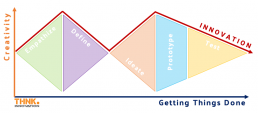Getting (Creative) Things Done with Design Thinking
July 2, 2020 by David Hauser
During my years of working as an industrial design engineer and project manager, I learned that there are two domains in the business world that are often believed to be opposed to and competing with each other. Depending on which side of the fence I placed myself due to the role that I was assigned to, I argued for and against the importance and priority of one against the other.
Can you guess what these two domains are?
I’m talking about Creativity and Execution!
In his book Getting Things Done – The art of stress-free productivity, author David Allen describes the ability to get things done (GTD) as the ability to do what needs to be done or what you chose to get accomplished by minimising distractions. One of his main lessons is that we should get started with his GTD-practice by tidying up. Tidying up everything from our to-do and bucket lists to our desks and any databases that we are working with.
But most importantly, tidying up the database that we are carrying around in our heads by emptying it out into a physical notebook or a piece of suitable software.

The idea behind it is that our brains only have a limited capacity to deal with multiple things at the same time. You can think about it like the RAM storage of your computer or smartphone. The storage in which every set of data is temporarily held ready to access for all the programs, apps, and widgets that are open at any given time. It can only deal with so many requests from active software before its capacity is reached and it will slow your device and applications down, or in a worst-case even causing them to crash.
And the very same principle applies to our brains, too.
The more open tasks we are carrying around in our brains, the more open loops we are thinking of at any given time, the more of its capacity is diverted away from the most important task. The result is that we are getting slowed down in our efforts to accomplish our set goals.
Getting all our ideas out of our head by writing them down in whatever form we chose to, is the equivalent of closing a program or app that we are not using right at the moment. The information or work in progress is not getting lost but stored in a secure location to which we can go back and pick it up again exactly where we left off. But for the moment it frees up our brain capacity to focus on our tasks on hand with minimal risk of internal distraction and confusion.
As a result, we are getting the work done quicker and are most likely delivering it in higher quality, too. And all of it with plenty of time left to spare.
Time to be used for being creative.
Time for developing ideas about how to generate new value.
Time to care for your customers, your business, your loved ones, or yourself.
The Design Thinking methodology can do the very same for you and your operation, too, by providing you with a plan of when to be creative and ideate, and when you have to get things done.

No model of the methodology is visualising this better than the double diamond.
It is the double diamond model of the design thinking process that is visualising it best.
Divided into the 5 steps of Empathise, Define, Ideate, Prototype, Test, it defines clearly where there is space for being creative and when we have to get to it and get it done!
In the Empathise and Ideate stages of the process, you are encouraged to be creative, explore new ideas, and think out of your own boxes.
Whereas in the Define and Prototype/Test stages you are bringing everything back to the point, execute, and getting things done.
Reading the double diamond diagram as a project timeline with the time axis in the horizontal, it becomes quite clear that creativity and execution -or getting things done- are not opposing each other but are working together.
Efficient execution and getting to point with a purpose are freeing up time that can be used for more creative thinking and the generation of more ideas to explore. And more ideas are giving you and your business more options to execute on and create more value due to more and better products, services, and processes or reaching more customers and clients.
It is the execution of creative ideas that is creating innovation!
At THNK.innovation we are applying design thinking and other innovation strategies to help small businesses, teams, and individuals to generate new ideas that combine efficient ways of working with a structured approach to creativity.
Please get in touch to explore how we can help you and your team, too!
Like what you read? Share it
